PEAK IPEH-002064 User manual
- Category
- Interface cards/adapters
- Type
- User manual
This manual is also suitable for

PCAN-PCI
PCI to CAN Interface
User Manual
V2.2.0

PCAN-PCI – User Manual
2
Products taken into account
Product Name Model Part Number
PCAN-PCI Single Channel One CAN channel IPEH-002064
PCAN-PCI Dual Channel Two CAN channels IPEH-002065
PCAN-PCI Single Channel
opto-decoupled
One CAN channel, galvanic
isolation for CAN connection
IPEH-002066
PCAN-PCI Dual Channel
opto-decoupled
Two CAN channels, galvanic
isolation for CAN connections
IPEH-002067
The cover picture shows the product PCAN-PCI Dual Channel opto-decoupled. Other
product versions have an identical form factor but vary in equipment.
CANopen® and CiA® are registered communi
ty trade marks of CAN in Automation
e.v.
All other product names mentioned in this manual may be the trademarks or
registered trademarks of their respective companies. They are not explicitly marked
by “™” and “®”.
© 2012 PEAK-System Technik GmbH
PEAK-System Technik GmbH
Otto-Roehm-Strasse 69
64293 Darmstadt
Germany
Phone: +49 (0)6151 8173-20
Fax: +49 (0)6151 8173-29
www.peak-system.com
info@peak-system.com
Documen
t version 2.2.0 (2012-10-17)

PCAN-PCI – User Manual
3
Contents
1. Introduction 4
1.1 Properties at a Glance 4
1.2 System Requirements 5
1.3 Scope of Supply 5
2. Installing the Software and the Card 6
3. Connecting the CAN Bus 9
3.1 D-Sub connector 9
3.2 Supplying External Devices via the CAN
Connector 10
3.3 Cabling 12
3.3.1 Termination 12
3.3.2 Example of a Connection 12
3.3.3 Maximum Bus Length 13
4. Using the Software 14
4.1 CAN Monitor PCAN-View for Windows 14
4.1.1 Receive/Transmit Tab 16
4.1.2 Trace Tab 18
4.1.3 Status Bar 19
4.2 Linking Own Programs with PCAN-Basic 20
4.2.1 Features of PCAN-Basic 21
4.2.2 Principle Description of the API 22
4.2.3 Notes about the License 23
5. Technical Specifications PCAN-PCI 24
Appendix A CE Certificate 26
Appendix B Dimension Drawing 27
Appendix C Quick Reference 28

PCAN-PCI – User Manual
4
1. Introduction
The PCAN-PCI card provides one or two CAN channels in computers
with PCI slots. Device drivers and programming interfaces exist for
different operating systems, so programs can easily access a
connected CAN bus.
Tip: At the end of this manual (Appendix C) you can find a
Quick Reference with brief information about the installation
and operation of the PCAN-PCI card.
1.1 Properties at a Glance
PC plug-in card for PCI slot
1 or 2 High-speed CAN channels (ISO 11898-2)
Bit rates up to 1 Mbit/s
Compliant with CAN specifications 2.0A (11-bit ID)
and 2.0B (29-bit ID)
CAN bus connection via D-Sub, 9-pin
(in accordance with CiA® 102)
NXP SJA1000 CAN controller, 16 MHz clock frequency
NXP PCA82C251 CAN transceiver
Galvanic isolation on the CAN connection up to 500 V (only
opto-decoupled versions), separate for each CAN channel
5-Volts supply to the CAN connection can be connected through
a solder jumper, e.g. for external bus converter
Extended operating temperature range from -40 to 85 °C
(-40 to 185 °F)

PCAN-PCI – User Manual
5
Note: This manual describes the use of the PCAN-PCI card with
Windows. You can find device drivers for Linux and the
corresponding application information on the provided DVD in
the directory branch Develop and on our website under
www.peak-system.com/linux.
1.2 System Requirements
A vacant PCI slot in the computer
Operating system Windows 7/Vista/XP (32/64-bit)
or Windows CE 6.x (x86 and ARMv4 processor support)
or Linux (32/64-bit)
1.3 Scope of Supply
PCAN-PCI card
Device drivers for Windows 7/Vista/XP (32/64-bit)
and Linux (32/64-bit)
Device driver for Windows CE 6.x
(x86 and ARMv4 processor support)
PCAN-View CAN monitor for Windows
PCAN-Basic programming interface consisting of an interface
DLL, examples, and header files for all common programming
languages
Manual in PDF format

PCAN-PCI – User Manual
6
2. Installing the Software and
the Card
This chapter covers the software setup for the PCAN-PCI card under
Windows and the installation of the card in the computer.
Setup the driver before
installing the PCAN-PCI card.
Do the following to install the driver:
1. Make sure that you are logged in as user with administrator
privileges (not needed for normal use of the PCAN-PCI card
later on).
2. Insert the supplied DVD into the appropriate drive of the
computer. Usually a navigation program appears a few
moments later. If not, start the file Intro.exe from the root
directory of the DVD.
3. On the page English > Drivers activate the entry PCAN-PCI.
4. Click on Install now. The setup program for the driver is
executed.
5. Follow the instructions of the setup program.
Tip: If you don't want to install the CAN monitor PCAN-View for
Windows onto the hard disk together with the driver, you have
the option to start the program later directly from DVD without
prior installation.

PCAN-PCI – User Manual
7
Do the following to install the PCAN-PCI card in the computer:
Attention! Electrostatic discharge (ESD) can damage or destroy
components on the PCAN-PCI card. Take precautions to avoid
ESD when handling the card.
Figure 1: Position of the CAN connectors CAN 1 (lower position)
and CAN 2 (upper position). In the Single Channel version,
CAN 1 remains at the same position
1. Shut down the computer.
2. Disconnect the computer from the power supply.
3. Open the computer's casing.
4. Insert the PCAN-PCI card into an empty PCI slot. For details
please refer to the documentation of the computer.
5. Close the computer's casing.
6. Reconnect the power supply of the computer.

PCAN-PCI – User Manual
8
Do the following to complete the initialization:
1. Turn on the computer and start Windows. Make sure that
you are logged in as user with administrator privileges.
Windows notifies that new hardware has been detected.
2. Windows XP only: A Wizard dialog box appears. Follow its
instructions. Deny the search for driver software at
Windows update and select the automatic software
installation during the procedure.
All Windows operating systems: The drivers are found and
installed by Windows.
3. Afterwards you can work as user with restricted rights
again.
After the initialization process is finished successfully you can find
the entry “PCAN-PCI” in the branch “CAN-Hardware” of the
Windows Device Manager.

PCAN-PCI – User Manual
9
3. Connecting the CAN Bus
3.1 D-Sub connector
A High-speed CAN bus (ISO 11898-2) is connected to the 9-pin
D-Sub connector. The pin assignment for CAN corresponds to the
specification CiA® 102.
Figure 2: Pin assignment of High-speed CAN connection
(view onto a male connector on the PCAN-PCI card)
With the pins 1 and 9 devices with low power consumption (e.g. bus
converters) can be directly supplied via the CAN connector. At deli-
very these pins are not assigned. You can find a detailed description
in the following section 3.2.
Tip: You can connect a CAN bus with a different transmission
standard via a bus converter. PEAK-System offers different bus
converter modules (e.g. PCAN-TJA1054 for a Low-speed CAN
bus according to ISO 11898-3).

PCAN-PCI – User Manual
10
3.2 Supplying External Devices via the CAN
Connector
A 5-Volt supply can optionally be routed to pin 1 and/or pin 9 of a D-
Sub connector by setting solder bridges on the PCAN-PCI card
(independently for each connector on the Dual Channel versions).
Thus devices with low power consumption (e.g. bus converters) can
be directly supplied via the CAN connector.
When using this option the 5-Volt supply is connected to the power
supply of the computer and is not fused separately. The opto-
decoupled versions of the card contain an interconnected DC/DC
converter. Therefore the current output is limited to about 50 mA.
Proceed as follows to activate the 5-Volt supply:
Attention! Electrostatic discharge (ESD) can damage or destroy
components on the PCAN-PCI card. Take precautions to avoid
ESD when handling the card.
Set the solder bridge(s) on the PCAN-PCI card according to the
desired settings. During this procedure take especially care not to
produce unwanted short circuits on the card.
Figure 3 shows the positions of the solder fields on the PCAN-PCI
card. The
table below contains the possible settings.

PCAN-PCI – User Manual
11
Figure 3: PCAN-PCI card, LJ21 (lower marker) and LJ22 (upper marker)
5-Volt supply →
None Pin 1 Pin 9 Pin 1 + Pin 9
LJ21 (CAN channel 1) /
LJ22 (CAN channel 2)
Attention! Risk of short circuit! If the option described in this
section is activated, you may only connect or disconnect CAN
cables or peripheral systems (e.g. bus converters) to or from
the PCAN-PCI card while the computer is de-energized.

PCAN-PCI – User Manual
12
3.3 Cabling
3.3.1 Termination
A High-speed CAN bus (ISO 11898-2) must be terminated on both
ends with 120 Ohms. Otherwise, there are interfering signal
reflections and the transceivers of the connected CAN nodes (CAN-
interface, control device) will not work.
The PCAN-PCI card does not have an internal termination. Use the
card on a terminated CAN bus.
3.3.2 Example of a Connection
Figure 4: Simple CAN connection
In this example, the PCAN-PCI card is connected with a control unit
by a cable that is terminated at both ends.

PCAN-PCI – User Manual
13
3.3.3 Maximum Bus Length
High-Speed-CAN networks may have bit rates of up to 1 Mbit/s. The
maximum bus length depends primarily on the bit rate.
The following table shows the maximum possible CAN bus length
at different bit rates:
Bit rate Bus length
1 Mbit/s 40 m
500 kbit/s 110 m
250 kbit/s 240 m
125 kbit/s 500 m
50 kbit/s 1.3 km
20 kbit/s 3.3 km
10 kbit/s 6.6 km
5 kbit/s 13.0 km
The listed values have been calculated on the basis of an idealized
system and can differ from reality.

PCAN-PCI – User Manual
14
4. Using the Software
This chapter covers the provided software PCAN-View and the
programming interface PCAN-Basic.
4.1 CAN Monitor PCAN-View for Windows
PCAN-View for Windows is a simple CAN monitor for viewing,
transmitting, and logging CAN messages.
Figure 5: PCAN-View for Windows
Do the following to start and initialize PCAN-View:
1. If PCAN-View is already installed on the hard disk, open the
Windows Start menu, go to Programs > PCAN-Hardware,
and select the entry PCAN-View.
If you haven’t installed PCAN-View together with the device
driver, you can start the program directly from the supplied

PCAN-PCI – User Manual
15
DVD. In the navigation program (Intro.exe), go to English
> Tools, and under PCAN-View for Windows select the link
Start.
The dialog box for selecting the CAN hardware and for
setting the CAN parameters appears.
Figure 6: Selection of the CAN hardware and parameters
2. From the list Available CAN hardware select the CAN
channel to be used.
3. Select the bit rate that is used by all nodes on the CAN bus
from the dropdown list Bit rate.
4. Under Filter settings you can limit the range of CAN IDs to
be received, either for standard frames (11-bit IDs) or for
extended frames (29-bit IDs).
5. Finally confirm the settings in the dialog box with OK. The
main window of PCAN-View appears (see Figure 7).

PCAN-PCI – User Manual
16
4.1.1 Receive/Transmit Tab
Figure 7: Receive/Transmit tab
The Receive/Transmit tab is the main element of PCAN-View. It
contains two lists, one for received messages and one for the
transmit messages. Representation of CAN data is in hexadecimal
format.
Do the following to transmit a CAN message with PCAN-View:
1. Select the menu command Transmit > New Message
(alternatively or Ins).
The dialog box New Transmit Message is shown.

PCAN-PCI – User Manual
17
Figure 8: Dialog box New transmit message
2. Enter the ID and the data for the new CAN message.
3. The field Cycle Time indicates if the message shall be
transmitted manually or periodically. If you want to transmit
the message periodically, you must enter a value greater
than 0. For a manual-only transmission enter 0.
4. Confirm the entries with OK.
The created transmit message appears on the
Receive/Transmit tab.
5. You trigger selected transmit messages manually with the
menu command Transmit > Send (alternatively Space bar).
The manual transmission for CAN messages being
transmitted periodically is carried out additionally.
Tip: Using the menu command File > Save the current transmit
messages can be saved to a list and loaded for reuse later on.

PCAN-PCI – User Manual
18
4.1.2 Trace Tab
Figure 9: Trace tab
On the Trace tab the data tracer of PCAN-View is used for logging
the communication on a CAN bus. During this process the CAN
messages are cached in the working memory of the PC. Afterwards
they can be saved to a file.
The tracer can be configured to run in linear or in ring buffer mode.
In linear buffer mode the logging is stopped as soon as the buffer is
filled completely. In ring buffer mode the oldest messages are
overwritten by incoming ones.

PCAN-PCI – User Manual
19
4.1.3 Status Bar
Figure 10: Display of the status Bar
The status bar shows information about the current CAN
connection, about error counters (Overruns, QXmtFull) and shows
error messages.
You can find further information about the use of PCAN-View in the
help which you can invoke in the program via the menu Help or the
F1 key.

PCAN-PCI – User Manual
20
4.2 Linking Own Programs with PCAN-Basic
Figure 11: PCAN-Basic
On the provided DVD you can find files of the programming
interface PCAN-Basic in the directory branch Develop. This API
provides basic functions for linking own programs to CAN
interfaces by PEAK-System and can be used for the following
operating systems:
Windows 7/Vista/XP (32/64-bit)
Windows CE 6.x (x86/ARMv4)
The API is designed for cross-platform use. Therefore software
projects can easily ported between platforms with low efforts.
PEAK-System has created examples for the following programming
languages: C++, C#, C++/CLR, Visual Basic, Delphi, Python, and
Java.
Page is loading ...
Page is loading ...
Page is loading ...
Page is loading ...
Page is loading ...
Page is loading ...
Page is loading ...
Page is loading ...
-
 1
1
-
 2
2
-
 3
3
-
 4
4
-
 5
5
-
 6
6
-
 7
7
-
 8
8
-
 9
9
-
 10
10
-
 11
11
-
 12
12
-
 13
13
-
 14
14
-
 15
15
-
 16
16
-
 17
17
-
 18
18
-
 19
19
-
 20
20
-
 21
21
-
 22
22
-
 23
23
-
 24
24
-
 25
25
-
 26
26
-
 27
27
-
 28
28
PEAK IPEH-002064 User manual
- Category
- Interface cards/adapters
- Type
- User manual
- This manual is also suitable for
Ask a question and I''ll find the answer in the document
Finding information in a document is now easier with AI
Related papers
-
PEAK IPEH-002093 User manual
-
PEAK PCAN-PC/104-Plus User manual
-
PEAK IPEH-002093 User manual
-
PEAK IPEH-002093 User manual
-
PEAK PCAN-PC/104 User manual
-
PEAK IPEH-003040 User manual
-
PEAK PCAN-PCI Express User manual
-
PEAK IPEH-003040 User manual
-
PEAK PCAN-PCI User manual
-
PEAK PCAN-PCI Express User manual
Other documents
-
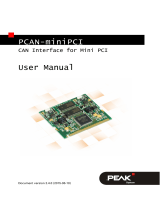 PEAK-System PCAN-miniPCI Operating instructions
PEAK-System PCAN-miniPCI Operating instructions
-
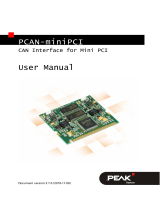 PEAK-System PCAN-miniPCI Operating instructions
PEAK-System PCAN-miniPCI Operating instructions
-
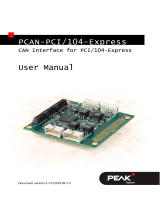 PEAK-System PCAN-PC/104-Express Operating instructions
PEAK-System PCAN-PC/104-Express Operating instructions
-
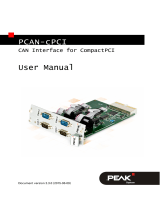 PEAK-System PCAN-cPCI Operating instructions
PEAK-System PCAN-cPCI Operating instructions
-
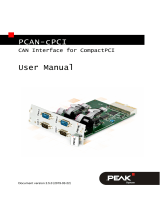 PEAK-System PCAN-cPCI Operating instructions
PEAK-System PCAN-cPCI Operating instructions
-
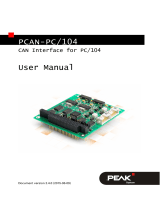 PEAK-System PCAN-PC/104 Operating instructions
PEAK-System PCAN-PC/104 Operating instructions
-
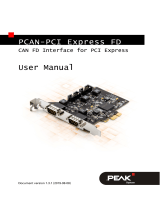 PEAK-System PCAN-PCI Express FD Operating instructions
PEAK-System PCAN-PCI Express FD Operating instructions
-
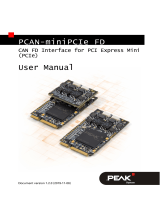 PEAK-System PCAN-miniPCIe FD Operating instructions
PEAK-System PCAN-miniPCIe FD Operating instructions
-
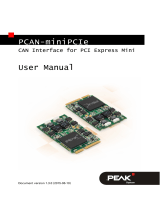 PEAK-System PCAN-miniPCIe Operating instructions
PEAK-System PCAN-miniPCIe Operating instructions
-
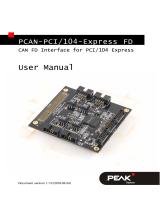 PEAK-System PCAN-PC/104-Express FD Operating instructions
PEAK-System PCAN-PC/104-Express FD Operating instructions





































